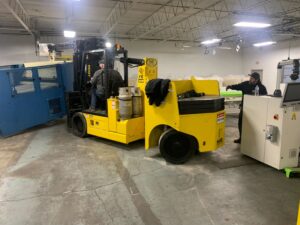Warehousing is a critical component of supply chain management, serving as a hub for the storage, handling, and distribution of goods. However, the dynamic nature of the industrial landscape introduces various risks that can impact the efficiency and effectiveness of warehousing operations. In this article, we will delve into the intricacies of risk management in warehousing, exploring the challenges faced by these facilities and how industrial services play a pivotal role in mitigating these risks.
Understanding the Landscape of Warehousing Risks
Types of Risks in Warehousing
Warehousing operations are exposed to a myriad of risks that can disrupt the seamless flow of goods. These risks can be broadly categorized into operational, financial, and strategic. Operational risks include issues such as inventory errors, equipment failures, and labor shortages. Financial risks may involve fluctuations in costs, currency exchange rates, or unexpected expenses. Strategic risks pertain to challenges in aligning warehousing processes with overall business strategies. Identifying and understanding these risks is the first step in developing effective risk management strategies.
Operational Risks in Warehousing
1. Inventory Management Challenges: Maintaining accurate inventory records is crucial for preventing stockouts or overstock situations. Any discrepancies in inventory levels can lead to order fulfillment delays, customer dissatisfaction, and financial losses.
2. Equipment Failures and Downtime: Warehouses heavily rely on various equipment such as forklifts, conveyor systems, and automated machinery. Breakdowns or malfunctions can halt operations, resulting in delays and increased maintenance costs.
3. Labor Shortages and Skill Gaps: The availability of skilled labor is a constant concern in the warehousing industry. Shortages or a lack of expertise can lead to inefficiencies, errors, and increased training expenses.
Financial Risks in Warehousing
1. Cost Fluctuations: Warehousing costs, including rent, labor, and utilities, can fluctuate due to economic conditions, market trends, or unexpected events. These fluctuations can impact the overall financial health of the warehouse.
2. Currency Exchange Risks: For warehouses involved in international trade, fluctuations in currency exchange rates can affect the cost of imported goods and impact profit margins.
3. Unexpected Expenses: Unforeseen events such as natural disasters, accidents, or regulatory changes can result in unexpected expenses. Without proper financial planning, warehouses may struggle to absorb these costs.
Strategic Risks in Warehousing
1. Alignment with Business Goals: Warehouses need to align their operations with the broader strategic goals of the business. Failure to do so can result in inefficiencies, missed opportunities, and a lack of adaptability to changing market conditions.
2. Technology Integration Challenges: Rapid technological advancements require warehouses to continually update their systems. The failure to integrate new technologies seamlessly can hinder operations and reduce overall competitiveness.
3. Market and Competition Dynamics: Changes in the market landscape and increasing competition can pose strategic challenges for warehouses. Staying ahead of industry trends and understanding customer demands are critical for sustained success.
The Role of Industrial Services in Mitigating Risks
Leveraging Industrial Services for Risk Mitigation
Industrial services play a pivotal role in mitigating the diverse risks faced by warehouses. These services encompass a range of solutions, technologies, and expertise aimed at optimizing operations, enhancing efficiency, and ensuring the overall resilience of the warehousing ecosystem.
Implementing Advanced Inventory Management Systems
1. Real-Time Tracking and Visibility: Industrial services offer advanced inventory management systems that provide real-time tracking and visibility into the movement of goods. This reduces the risk of inventory errors and ensures accurate order fulfillment.
2. Automation and Robotics: The integration of automation and robotics in warehousing minimizes the reliance on manual labor and reduces the risk of errors associated with human intervention. Automated systems also contribute to increased operational efficiency.
3. Data Analytics for Demand Forecasting: Leveraging data analytics, industrial services help warehouses analyze historical data to forecast demand accurately. This proactive approach enables warehouses to optimize inventory levels, reducing the risk of stockouts or excess inventory.
Preventive Maintenance and Equipment Monitoring
1. Predictive Maintenance Solutions: Industrial services provide predictive maintenance solutions that leverage sensor data and analytics to predict equipment failures before they occur. This proactive approach minimizes downtime and reduces the financial risks associated with unplanned maintenance.
2. Remote Monitoring and Diagnostics: With advanced remote monitoring capabilities, industrial services enable real-time tracking and diagnostics of warehouse equipment. This allows for quick identification and resolution of issues, minimizing disruptions to operations.
3. Training and Skill Development Programs: To address labor shortages and skill gaps, industrial services offer training and skill development programs. These programs enhance the expertise of warehouse personnel, reducing the risk of errors and improving overall operational efficiency.
Financial Planning and Risk Mitigation Strategies
1. Cost Optimization Services: Industrial services assist warehouses in optimizing costs by identifying areas for efficiency improvement. This may include energy-saving initiatives, process streamlining, and the adoption of cost-effective technologies.
2. Hedging Against Currency Exchange Risks: For warehouses involved in international trade, industrial services provide expertise in hedging strategies to mitigate the impact of currency exchange rate fluctuations. This ensures more predictable financial outcomes.
3. Emergency Response Planning: Industrial services help warehouses develop comprehensive emergency response plans to address unexpected events. This proactive approach minimizes the financial impact of unforeseen expenses by ensuring quick and efficient responses to emergencies.
Strategic Planning and Adaptability
1. Business Intelligence Solutions: Industrial services offer business intelligence solutions that provide warehouses with valuable insights into market trends, customer behavior, and competitor activities. This information is crucial for strategic planning and maintaining a competitive edge.
2. Technology Integration Consultation: To overcome technology integration challenges, industrial services provide consultation and support for the seamless adoption of new technologies. This ensures that warehouses stay technologically updated and can adapt to industry advancements.
3. Supply Chain Consultancy: Industrial services offer supply chain consultancy to align warehousing operations with broader business goals. This involves strategic planning, process optimization, and the identification of opportunities for growth and innovation.
Challenges and Opportunities in Implementing Industrial Services
Challenges in Implementing Industrial Services
While industrial services offer significant benefits in mitigating risks, their implementation is not without challenges. These challenges include:
Initial Investment Costs
1. High Initial Costs: Implementing advanced industrial services often requires a significant upfront investment. This can be a barrier for small and medium-sized warehouses with limited financial resources.
2. Return on Investment (ROI) Concerns: Some warehouses may hesitate to adopt industrial services due to concerns about the time it takes to realize a return on investment. Convincing stakeholders of the long-term benefits can be a challenge.
Integration Complexity
1. Integration with Existing Systems: Many warehouses already have established systems and processes in place. Integrating new industrial services with existing systems can be complex and may require careful planning and coordination.
2. Training and Change Management: The introduction of new technologies and processes often necessitates training for existing personnel. Resistance to change and the need for comprehensive training programs can pose implementation challenges.
Data Security and Privacy Concerns
1. Data Security Risks: Industrial services involve the collection and analysis of vast amounts of data. Ensuring the security of this data against potential cyber threats is a
critical consideration for warehouses.
2. Compliance with Data Privacy Regulations: Warehouses must adhere to data privacy regulations and standards. Ensuring compliance with these regulations while utilizing industrial services requires careful attention to legal and ethical considerations.
Opportunities and Future Trends in Industrial Services
Despite the challenges, the adoption of industrial services in warehousing presents numerous opportunities and aligns with emerging trends in the industry.
Advancements in Artificial Intelligence (AI) and Machine Learning (ML)
1. Predictive Analytics: The use of AI and ML in industrial services enables more accurate predictive analytics. This enhances the ability to foresee potential risks and take proactive measures to mitigate them.
2. Autonomous Systems: The development of autonomous systems, including autonomous vehicles and robots, further reduces the reliance on manual labor, minimizing the risks associated with human errors.
Sustainable Practices
1. Energy-Efficient Technologies: Industrial services are increasingly incorporating energy-efficient technologies to promote sustainability. This not only aligns with environmental goals but also helps in optimizing costs and reducing financial risks.
2. Circular Supply Chain Models: Warehouses are exploring circular supply chain models with the help of industrial services. These models focus on reducing waste, promoting recycling, and creating a more resilient and sustainable supply chain.
Integration of Internet of Things (IoT)
1. Real-Time Monitoring: IoT devices enable real-time monitoring of various aspects of warehousing operations, from equipment performance to environmental conditions. This facilitates quicker decision-making and risk mitigation.
2. Enhanced Connectivity: The integration of IoT devices enhances connectivity between different elements of the supply chain, fostering better collaboration and reducing the risks associated with disconnected systems.
Conclusion
In conclusion, risk management in warehousing is a multifaceted challenge that requires a holistic approach. Industrial services play a crucial role in mitigating operational, financial, and strategic risks by offering advanced solutions, expertise, and strategic guidance. While challenges exist in the implementation of these services, the opportunities for enhanced efficiency, cost optimization, and sustainability make them a strategic investment for warehouses looking to thrive in an ever-evolving industrial landscape. As the industry continues to embrace technological advancements and sustainable practices, the role of industrial services in risk management will only become more pronounced, paving the way for resilient and future-ready warehousing operations.























